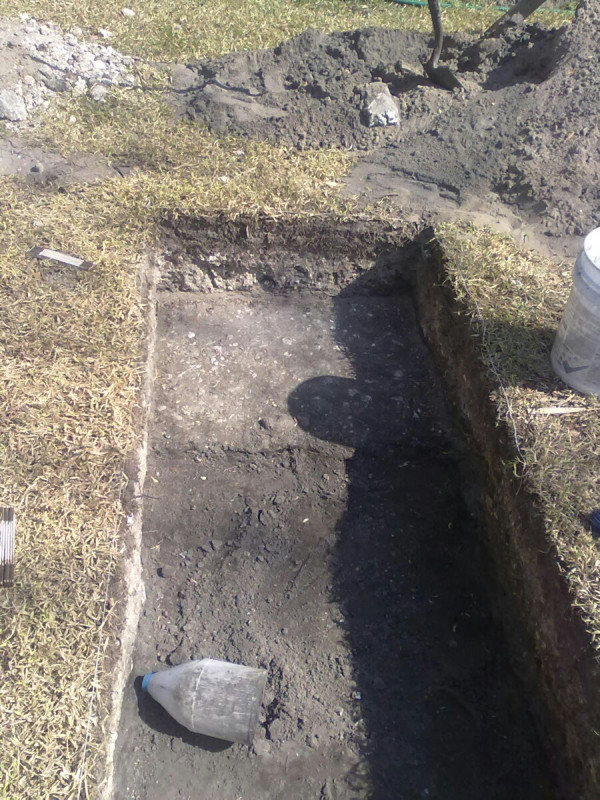Communicating with the Past: Entry #1, “Privy or a Trash Pit”
Note: this blog post is the first of an ongoing series written by Flagler College History students working on site with St. Augustine's City Archaeologist. You can visit the Flagler Public History blog here.
Located at 31 Cordova Street, the Flagler College Communications building stands as a reminder of the past. This building from the 1950s has served its purpose to the Flagler community, but now it is time to look to the future. During the fall of 2012 the school announced that they would be demolishing the building in order to construct an entirely new, up-to-date learning facility for students and professors. Send in the archaeologists!
As is customary in the nation’s oldest city - due to St. Augustine’s rich and ever-expanding history - whenever there are plans to build downtown, a local ordinance requires the City Archaeologist to excavate. I met with archaeology volunteer Nick McAuliffe at the site to learn more about what the team hopes to uncover, what they had already discovered, and to get a general impression of archaeological digs throughout the city. Nick greeted me and we immediately got to discussing what had already been discovered.
Located a few yards away from the communications building the team had discovered a tabby foundation of some sort, tabby being a form of shell-based concrete. This tabby foundation is believed to be some sort of roadway or the floor of a preexisting structure. There was debate over its purpose and the team had not confirmed a date for when it may have been laid.
Among the other finds were old pottery, tools, and shells, glass, and animals bones. These discoveries prompted the question “is this a privy or a trash pit?” – We will have to wait and see as the dig progresses. City Archaeologist Carl Halbirt and his team of volunteers and experts will continue to excavate the site over the next few months. Volunteers are welcome and encouraged to visit the site.
When I visited the dig site, there had not been much in the way of new discoveries, but it was interesting to learn about the techniques and reasons behind the dig itself. Techniques include using posthole diggers to get an idea of where the best spots to dig would be.
The team then proceeds to dig several holes, called test units, and analyzes the different soil stains located within each hole. The more stains found within a hole the more evidence of human activity at each layer.
Each layer correlates to a different period of history. The dirt is screened out, and artifacts are collected for later analysis, for each layer and feature.
When Carl is satisfied that his team has learned as much as possible in the allotted time, he signs off on the site. This allows construction to continue with the minimum of delay.
Located at 31 Cordova Street, the Flagler College Communications building stands as a reminder of the past. This building from the 1950s has served its purpose to the Flagler community, but now it is time to look to the future. During the fall of 2012 the school announced that they would be demolishing the building in order to construct an entirely new, up-to-date learning facility for students and professors. Send in the archaeologists!
As is customary in the nation’s oldest city - due to St. Augustine’s rich and ever-expanding history - whenever there are plans to build downtown, a local ordinance requires the City Archaeologist to excavate. I met with archaeology volunteer Nick McAuliffe at the site to learn more about what the team hopes to uncover, what they had already discovered, and to get a general impression of archaeological digs throughout the city. Nick greeted me and we immediately got to discussing what had already been discovered.
Located a few yards away from the communications building the team had discovered a tabby foundation of some sort, tabby being a form of shell-based concrete. This tabby foundation is believed to be some sort of roadway or the floor of a preexisting structure. There was debate over its purpose and the team had not confirmed a date for when it may have been laid.
 |
| The tabby wall foundation can be seen in this test unit, towards the top. Photo by Clayton Junkins |
Among the other finds were old pottery, tools, and shells, glass, and animals bones. These discoveries prompted the question “is this a privy or a trash pit?” – We will have to wait and see as the dig progresses. City Archaeologist Carl Halbirt and his team of volunteers and experts will continue to excavate the site over the next few months. Volunteers are welcome and encouraged to visit the site.
 |
| Volunteers sort through artifacts found in the excavation. Photo by Clayton Junkins |
When I visited the dig site, there had not been much in the way of new discoveries, but it was interesting to learn about the techniques and reasons behind the dig itself. Techniques include using posthole diggers to get an idea of where the best spots to dig would be.
 |
| Soil stains that delineate features such as trash pits and wells. Photo courtesy of Moises Sztylerman. |
The team then proceeds to dig several holes, called test units, and analyzes the different soil stains located within each hole. The more stains found within a hole the more evidence of human activity at each layer.
Each layer correlates to a different period of history. The dirt is screened out, and artifacts are collected for later analysis, for each layer and feature.
 |
| Shaker screen removes dirt, leaving behinds artifacts such as pottery sherds and this 150-year-old nail. Photo by Clayton Junkins. |
When Carl is satisfied that his team has learned as much as possible in the allotted time, he signs off on the site. This allows construction to continue with the minimum of delay.